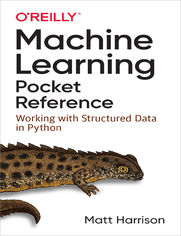Machine Learning Pocket Reference. Working with Structured Data in Python - Helion

ISBN: 978-14-920-4749-0
stron: 320, Format: ebook
Data wydania: 2019-08-27
Ksi─Ögarnia: Helion
Cena ksi─ů┼╝ki: 80,74 z┼é (poprzednio: 94,99 z┼é)
Oszczędzasz: 15% (-14,25 zł)
With detailed notes, tables, and examples, this handy reference will help you navigate the basics of structured machine learning. Author Matt Harrison delivers a valuable guide that you can use for additional support during training and as a convenient resource when you dive into your next machine learning project.
Ideal for programmers, data scientists, and AI engineers, this book includes an overview of the machine learning process and walks you through classification with structured data. You’ll also learn methods for clustering, predicting a continuous value (regression), and reducing dimensionality, among other topics.
This pocket reference includes sections that cover:
- Classification, using the Titanic dataset
- Cleaning data and dealing with missing data
- Exploratory data analysis
- Common preprocessing steps using sample data
- Selecting features useful to the model
- Model selection
- Metrics and classification evaluation
- Regression examples using k-nearest neighbor, decision trees, boosting, and more
- Metrics for regression evaluation
- Clustering
- Dimensionality reduction
- Scikit-learn pipelines
Osoby które kupowały "Machine Learning Pocket Reference. Working with Structured Data in Python", wybierały także:
- Jak zhakowa 125,00 zł, (10,00 zł -92%)
- Blockchain i kryptowaluty. Kurs video. Zdecentralizowane finanse od podstaw 118,90 zł, (11,89 zł -90%)
- Web scraping. Kurs video. Zautomatyzowane pozyskiwanie danych z sieci 126,36 zł, (13,90 zł -89%)
- GraphQL. Kurs video. Buduj nowoczesne API w Pythonie 153,64 zł, (16,90 zł -89%)
- Windows Media Center. Domowe centrum rozrywki 66,67 zł, (8,00 zł -88%)
Spis tre┼Ťci
Machine Learning Pocket Reference. Working with Structured Data in Python eBook -- spis tre┼Ťci
- Preface
- What to Expect
- Who This Book Is For
- Conventions Used in This Book
- Using Code Examples
- OReilly Online Learning
- How to Contact Us
- Acknowledgments
- 1. Introduction
- Libraries Used
- Installation with Pip
- Installation with Conda
- 2. Overview of the Machine Learning Process
- 3. Classification Walkthrough: Titanic Dataset
- Project Layout Suggestion
- Imports
- Ask a Question
- Terms for Data
- Gather Data
- Clean Data
- Create Features
- Sample Data
- Impute Data
- Normalize Data
- Refactor
- Baseline Model
- Various Families
- Stacking
- Create Model
- Evaluate Model
- Optimize Model
- Confusion Matrix
- ROC Curve
- Learning Curve
- Deploy Model
- 4. Missing Data
- Examining Missing Data
- Dropping Missing Data
- Imputing Data
- Adding Indicator Columns
- 5. Cleaning Data
- Column Names
- Replacing Missing Values
- 6. Exploring
- Data Size
- Summary Stats
- Histogram
- Scatter Plot
- Joint Plot
- Pair Grid
- Box and Violin Plots
- Comparing Two Ordinal Values
- Correlation
- RadViz
- Parallel Coordinates
- 7. Preprocess Data
- Standardize
- Scale to Range
- Dummy Variables
- Label Encoder
- Frequency Encoding
- Pulling Categories from Strings
- Other Categorical Encoding
- Date Feature Engineering
- Add col_na Feature
- Manual Feature Engineering
- 8. Feature Selection
- Collinear Columns
- Lasso Regression
- Recursive Feature Elimination
- Mutual Information
- Principal Component Analysis
- Feature Importance
- 9. Imbalanced Classes
- Use a Different Metric
- Tree-based Algorithms and Ensembles
- Penalize Models
- Upsampling Minority
- Generate Minority Data
- Downsampling Majority
- Upsampling Then Downsampling
- 10. Classification
- Logistic Regression
- Naive Bayes
- Support Vector Machine
- K-Nearest Neighbor
- Decision Tree
- Random Forest
- XGBoost
- Gradient Boosted with LightGBM
- TPOT
- 11. Model Selection
- Validation Curve
- Learning Curve
- 12. Metrics and Classification Evaluation
- Confusion Matrix
- Metrics
- Accuracy
- Recall
- Precision
- F1
- Classification Report
- ROC
- Precision-Recall Curve
- Cumulative Gains Plot
- Lift Curve
- Class Balance
- Class Prediction Error
- Discrimination Threshold
- 13. Explaining Models
- Regression Coefficients
- Feature Importance
- LIME
- Tree Interpretation
- Partial Dependence Plots
- Surrogate Models
- Shapley
- 14. Regression
- Baseline Model
- Linear Regression
- SVMs
- K-Nearest Neighbor
- Decision Tree
- Random Forest
- XGBoost Regression
- LightGBM Regression
- 15. Metrics and Regression Evaluation
- Metrics
- Residuals Plot
- Heteroscedasticity
- Normal Residuals
- Prediction Error Plot
- 16. Explaining Regression Models
- Shapley
- 17. Dimensionality Reduction
- PCA
- UMAP
- t-SNE
- PHATE
- 18. Clustering
- K-Means
- Agglomerative (Hierarchical) Clustering
- Understanding Clusters
- 19. Pipelines
- Classification Pipeline
- Regression Pipeline
- PCA Pipeline
- Index





